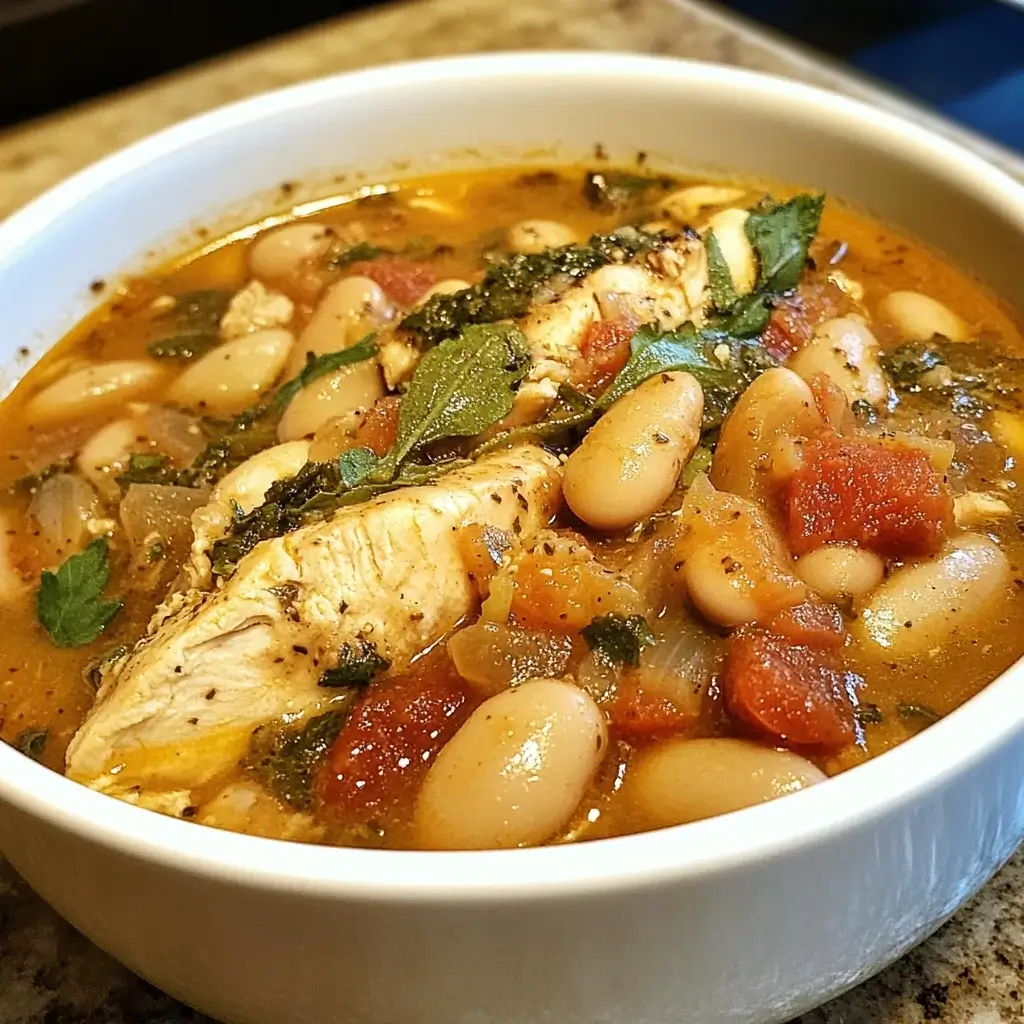There are certain dishes that just feel like a warm hug from the inside out. For me, Tuscan White Bean and Chicken Stew is one of those recipes. From the moment the aroma of sautéed garlic and herbs starts to fill my kitchen, I know we’re in for a treat. This isn’t just a stew; it’s a culinary journey to the heart of Italy, a simple yet profoundly flavorful dish that my family absolutely devours. Even my pickiest eater, who usually shies away from anything resembling a “stew,” asks for seconds of this one. The creamy cannellini beans melt in your mouth, the tender chicken is infused with savory herbs, and the broth is rich and comforting. It’s the kind of meal that’s perfect for a chilly evening, a cozy weekend lunch, or even a casual dinner party. Honestly, I’ve made this stew countless times, tweaking it here and there, and each time it brings the same joy and satisfaction. It’s become a staple in our home, a testament to the magic of simple, high-quality ingredients transformed into something truly special. If you’re looking for a recipe that’s both easy to make and incredibly delicious, look no further. This Tuscan White Bean and Chicken Stew is guaranteed to become a new favorite in your kitchen too.
Ingredients
- Chicken Thighs: Provides a richer flavor and stays moist during slow cooking. (About 1.5 – 2 lbs, boneless, skinless)
- Cannellini Beans: Creamy white beans that are the heart of this Tuscan stew. (2 cans, 15 oz each, drained and rinsed)
- Chicken Broth: Forms the flavorful base of the stew, enhancing the chicken and bean flavors. (6 cups, low sodium preferred)
- Yellow Onion: Aromatic base, adds sweetness and depth to the stew. (1 large, chopped)
- Carrots: Adds sweetness, color, and nutritional value. (2 medium, chopped)
- Celery: Contributes to the aromatic base and adds a subtle savory note. (2 stalks, chopped)
- Garlic: Essential for Italian flavor, provides pungent aroma and taste. (4 cloves, minced)
- Dried Rosemary: Classic Tuscan herb, adds a piney and earthy flavor. (2 teaspoons, dried)
- Dried Thyme: Another key herb, complements rosemary with its earthy and slightly minty notes. (1 teaspoon, dried)
- Bay Leaf: Infuses a subtle, aromatic depth throughout the stew. (1 bay leaf)
- Olive Oil: Authentic Italian cooking staple, used for sautéing and richness. (3 tablespoons, extra virgin)
- Dry White Wine: Adds acidity and complexity to the broth. (½ cup, optional but recommended, such as Pinot Grigio or Sauvignon Blanc)
- Fresh Parsley: Brightens the stew with fresh, herbaceous notes and adds a pop of color. (¼ cup, chopped, for garnish)
- Salt and Black Pepper: Essential seasonings to enhance all the flavors. (To taste)
- Red Pepper Flakes: (Optional) Adds a subtle warmth and a hint of spice. (¼ teaspoon or to taste)
Instructions
- Prep the Chicken and Vegetables: Pat the chicken thighs dry with paper towels and season generously with salt and black pepper. Chop the onion, carrots, and celery into roughly equal-sized pieces. Mince the garlic.
- Sauté Aromatics: Heat olive oil in a large, heavy-bottomed pot or Dutch oven over medium heat. Add the chopped onion, carrots, and celery and sauté for about 5-7 minutes, or until the vegetables begin to soften and the onion becomes translucent. Stir occasionally to prevent sticking.
- Add Garlic and Herbs: Add the minced garlic, dried rosemary, dried thyme, and red pepper flakes (if using) to the pot. Cook for another minute, stirring constantly, until fragrant. Be careful not to burn the garlic.
- Sear the Chicken: Push the vegetables to one side of the pot and add the seasoned chicken thighs. Sear the chicken for about 3-4 minutes per side, until browned. You don’t need to cook it through at this stage, just develop some color for flavor.
- Deglaze with White Wine (Optional): If using white wine, pour it into the pot and scrape up any browned bits from the bottom of the pot with a wooden spoon. Let the wine simmer for a minute or two, allowing the alcohol to evaporate slightly.
- Add Broth, Beans, and Bay Leaf: Pour in the chicken broth, add the drained and rinsed cannellini beans, and the bay leaf. Stir everything together to combine.
- Simmer the Stew: Bring the stew to a simmer, then reduce the heat to low, cover the pot, and let it simmer gently for at least 30-45 minutes, or up to 1 hour. Simmering longer allows the flavors to meld and deepen, and the chicken to become incredibly tender.
- Shred the Chicken: Remove the chicken thighs from the pot and place them on a cutting board. Using two forks, shred the chicken into bite-sized pieces. Discard the bay leaf from the stew.
- Return Chicken and Simmer Further: Return the shredded chicken to the pot. Stir to combine and continue to simmer for another 10-15 minutes to allow the chicken to absorb the flavors of the stew.
- Season and Serve: Taste the stew and adjust seasoning with salt and black pepper as needed. Stir in fresh parsley just before serving. Ladle the Tuscan White Bean and Chicken Stew into bowls and serve hot. Garnish with extra fresh parsley, a drizzle of olive oil, or a sprinkle of red pepper flakes, if desired.
Nutrition Facts
(Per Serving, approximately based on 6 servings)
- Serving Size: Approximately 1.5 cups
- Calories: 450-550 kcal (Approximate, can vary based on ingredient quantities and chicken fat content)
- Protein: 40-45g
(Note: Nutritional information is an estimate and may vary based on specific ingredients and portion sizes. For accurate nutritional information, use a nutrition calculator with specific ingredient brands and quantities.)
Preparation Time
Prep Time: 20 minutes (chopping vegetables, prepping chicken)
Cook Time: 45 minutes – 1 hour 15 minutes (sautéing, simmering, shredding)
Total Time: Approximately 1 hour 5 minutes – 1 hour 35 minutes
This Tuscan White Bean and Chicken Stew is wonderfully straightforward to prepare. Most of the time is hands-off simmering, allowing the flavors to develop beautifully. It’s a perfect recipe for a weeknight meal or a relaxed weekend cooking session.
How to Serve
This versatile Tuscan White Bean and Chicken Stew can be served in a variety of delicious ways:
- Classic Bowl: Simply ladle generous portions into bowls and enjoy as a hearty and satisfying stew on its own.
- With Crusty Bread: Serve alongside slices of crusty Italian bread, sourdough, or baguette for dipping into the flavorful broth.
- Over Polenta: Spoon the stew over creamy polenta for a comforting and rustic Italian-inspired meal.
- With Pasta: Serve over short pasta shapes like ditalini, orecchiette, or shells for a heartier dish.
- Topped with Parmesan: Grate fresh Parmesan cheese over the stew just before serving for added richness and salty flavor.
- With a Green Salad: Balance the richness of the stew with a light and refreshing side salad dressed with a simple vinaigrette.
- Garnished with Pesto: A dollop of pesto on top adds a vibrant herbaceousness and extra flavor dimension.
- As Leftovers: This stew is even better the next day! The flavors meld together beautifully overnight, making it perfect for meal prepping or enjoying leftovers for lunch.
Additional Tips for the Best Tuscan White Bean and Chicken Stew
Creating a delicious Tuscan white bean and chicken stew is not just about following a recipe; it’s about understanding the nuances that lead to an extraordinary dish. Here are some expanded tips to help you achieve the best flavor, texture, and nutritional value in your stew:
Quality Ingredients Matter
The foundation of any great stew lies in the quality of its ingredients. Begin with a high-quality chicken broth, preferably homemade or a low-sodium option that allows you to control the saltiness of your dish. The depth of flavor in your broth will significantly influence the overall taste of the stew. Additionally, opt for a premium extra virgin olive oil; this not only enhances the flavor but also adds richness and a hint of fruitiness that complements the other ingredients. Fresh herbs, such as rosemary, thyme, and parsley, should be used instead of dried ones whenever possible. Fresh herbs have a vibrant flavor profile that can elevate your dish, giving it an aromatic quality that dried herbs simply can’t match.
Don’t Skip the Searing
Searing the chicken thighs is a crucial step that should never be overlooked. This process caramelizes the exterior of the meat, creating a golden-brown crust that is packed with flavor. These browned bits, known as fond, cling to the bottom of your pot and serve as a flavor base for your stew. To achieve the best sear, ensure your pan is hot before adding the chicken and allow it to cook undisturbed for several minutes. Once you’ve achieved a nice crust, flip the chicken to sear the other side. This step not only enhances the flavor but also seals in the juices, keeping your chicken tender and succulent during the simmering process.
Simmer Low and Slow
Patience is key when it comes to simmering your stew. Cooking it on low heat for an extended period allows the flavors to meld beautifully and ensures the chicken becomes incredibly tender. If you try to rush this process by cooking on high heat, you risk toughening the chicken and not allowing the ingredients to harmonize. A low and slow simmer also helps the beans absorb more flavor from the broth and the chicken, enriching the overall taste. Aim for at least 30-45 minutes of simmering once all ingredients are combined, but feel free to extend this to an hour or more if time allows.
Taste and Adjust Seasoning
Seasoning is a dynamic aspect of cooking. As the stew develops, the flavors will evolve, so it’s essential to taste and adjust the seasoning throughout the cooking process. Start by adding an appropriate amount of salt and pepper at the beginning, but keep a tasting spoon handy! Depending on the saltiness of your broth and personal preference, you may need to add more salt or a squeeze of lemon juice at the end to brighten the flavors. Freshly cracked black pepper can also enhance the stew’s complexity, so don’t hesitate to experiment with this as well.
Use Dried Beans (For Even Richer Flavor)
For those looking to deepen the authenticity and richness of their stew, using dried cannellini beans can make a significant difference. Dried beans require a bit more prep work, but the flavor payoff is worth it. Soak 1 cup of dried beans overnight in plenty of water, then rinse and cook them until tender—this can take about 1-2 hours depending on the age and type of bean. Once cooked, add them to the stew along with the other ingredients. Be mindful to adjust the amount of broth you use, as dried beans absorb liquid during cooking. This method not only enhances the flavor but also provides a heartier texture to the dish.
Add Greens for Extra Nutrients
Incorporating greens such as spinach, kale, or escarole in the last ten minutes of cooking is an excellent way to boost the nutritional profile of your stew. These greens not only add a vibrant pop of color but also introduce a variety of vitamins and minerals, enhancing the dish’s overall health benefits. Make sure to chop the greens into bite-sized pieces to ensure they wilt quickly and integrate well into the stew.
Customize with Vegetables
One of the joys of stew-making is that it’s incredibly versatile. Feel free to customize your stew by adding other vegetables such as diced zucchini, bell peppers, or mushrooms. These additions can bring new flavors and textures to your dish. When incorporating these vegetables, add them at the same time as the carrots and celery, allowing them to soften and meld with the other ingredients during the cooking process.
Make it Vegetarian/Vegan
If you’re looking to create a vegetarian or vegan version of this stew, it’s entirely feasible by simply omitting the chicken and substituting it with vegetable broth. This will maintain the stew’s heartiness while catering to a plant-based diet. To add substance and satisfaction, consider including other hearty vegetables such as potatoes, sweet potatoes, or butternut squash. These ingredients not only contribute to the stew’s texture but also provide essential nutrients. For an added layer of flavor reminiscent of the savory depth that chicken provides, try incorporating smoked paprika; this ingredient can elevate the stew with a warm, smoky undertone that complements the other flavors beautifully.
By following these comprehensive tips, you can create a Tuscan white bean and chicken stew that is not only delicious but also deeply satisfying and nourishing. Enjoy the process of making this dish, and feel free to make it your own with personal touches and favorite ingredients!
Frequently Asked Questions (FAQ)
Q1: Can I use chicken breasts instead of chicken thighs?
A: While chicken thighs are recommended for their richer flavor and ability to stay moist, you can use chicken breasts. However, be careful not to overcook them as they can become dry. Reduce the simmering time slightly and check for doneness sooner.
Q2: Can I make this stew in a slow cooker?
A: Yes, this stew can be easily adapted for a slow cooker. Sauté the vegetables and sear the chicken in a skillet on the stovetop first, then transfer everything to the slow cooker along with the remaining ingredients. Cook on low for 6-8 hours or on high for 3-4 hours. Shred the chicken before serving.
Q3: Can I freeze Tuscan White Bean and Chicken Stew?
A: Absolutely! This stew freezes beautifully. Allow it to cool completely, then transfer it to freezer-safe containers or bags. It can be frozen for up to 3 months. Thaw overnight in the refrigerator and reheat gently on the stovetop or in the microwave.
Q4: I don’t have white wine, can I still make the stew?
A: Yes, the white wine is optional. It adds a layer of complexity, but the stew will still be delicious without it. You can substitute with a squeeze of lemon juice or a tablespoon of white wine vinegar at the end of cooking for a touch of acidity if you like.
Q5: What kind of white beans are best for this stew?
A: Cannellini beans are traditionally used and are ideal for their creamy texture. However, Great Northern beans or other white beans like navy beans can also be used as substitutes.
Q6: Can I add tomatoes to this stew?
A: While not traditionally Tuscan White Bean and Chicken Stew, you can certainly add diced tomatoes or crushed tomatoes for a slightly different flavor profile. Add about 1 can (14.5 oz) of diced tomatoes or ½ can (14.5 oz) of crushed tomatoes along with the broth.
Q7: How long does leftover stew last in the refrigerator?
A: Leftover Tuscan White Bean and Chicken Stew will last in the refrigerator for 3-4 days when stored properly in an airtight container.
Q8: Can I make this spicier?
A: Yes, you can easily adjust the spice level. Increase the amount of red pepper flakes, add a pinch of cayenne pepper, or serve with a drizzle of chili oil for extra heat. You can also add a fresh chili pepper, finely chopped, when sautéing the vegetables.

Tuscan White Bean and Chicken Stew
Ingredients
- Chicken Thighs: Provides a richer flavor and stays moist during slow cooking. (About 1.5 – 2 lbs, boneless, skinless)
- Cannellini Beans: Creamy white beans that are the heart of this Tuscan stew. (2 cans, 15 oz each, drained and rinsed)
- Chicken Broth: Forms the flavorful base of the stew, enhancing the chicken and bean flavors. (6 cups, low sodium preferred)
- Yellow Onion: Aromatic base, adds sweetness and depth to the stew. (1 large, chopped)
- Carrots: Adds sweetness, color, and nutritional value. (2 medium, chopped)
- Celery: Contributes to the aromatic base and adds a subtle savory note. (2 stalks, chopped)
- Garlic: Essential for Italian flavor, provides pungent aroma and taste. (4 cloves, minced)
- Dried Rosemary: Classic Tuscan herb, adds a piney and earthy flavor. (2 teaspoons, dried)
- Dried Thyme: Another key herb, complements rosemary with its earthy and slightly minty notes. (1 teaspoon, dried)
- Bay Leaf: Infuses a subtle, aromatic depth throughout the stew. (1 bay leaf)
- Olive Oil: Authentic Italian cooking staple, used for sautéing and richness. (3 tablespoons, extra virgin)
- Dry White Wine: Adds acidity and complexity to the broth. (½ cup, optional but recommended, such as Pinot Grigio or Sauvignon Blanc)
- Fresh Parsley: Brightens the stew with fresh, herbaceous notes and adds a pop of color. (¼ cup, chopped, for garnish)
- Salt and Black Pepper: Essential seasonings to enhance all the flavors. (To taste)
- Red Pepper Flakes: (Optional) Adds a subtle warmth and a hint of spice. (¼ teaspoon or to taste)
Instructions
- Prep the Chicken and Vegetables: Pat the chicken thighs dry with paper towels and season generously with salt and black pepper. Chop the onion, carrots, and celery into roughly equal-sized pieces. Mince the garlic.
- Sauté Aromatics: Heat olive oil in a large, heavy-bottomed pot or Dutch oven over medium heat. Add the chopped onion, carrots, and celery and sauté for about 5-7 minutes, or until the vegetables begin to soften and the onion becomes translucent. Stir occasionally to prevent sticking.
- Add Garlic and Herbs: Add the minced garlic, dried rosemary, dried thyme, and red pepper flakes (if using) to the pot. Cook for another minute, stirring constantly, until fragrant. Be careful not to burn the garlic.
- Sear the Chicken: Push the vegetables to one side of the pot and add the seasoned chicken thighs. Sear the chicken for about 3-4 minutes per side, until browned. You don’t need to cook it through at this stage, just develop some color for flavor.
- Deglaze with White Wine (Optional): If using white wine, pour it into the pot and scrape up any browned bits from the bottom of the pot with a wooden spoon. Let the wine simmer for a minute or two, allowing the alcohol to evaporate slightly.
- Add Broth, Beans, and Bay Leaf: Pour in the chicken broth, add the drained and rinsed cannellini beans, and the bay leaf. Stir everything together to combine.
- Simmer the Stew: Bring the stew to a simmer, then reduce the heat to low, cover the pot, and let it simmer gently for at least 30-45 minutes, or up to 1 hour. Simmering longer allows the flavors to meld and deepen, and the chicken to become incredibly tender.
- Shred the Chicken: Remove the chicken thighs from the pot and place them on a cutting board. Using two forks, shred the chicken into bite-sized pieces. Discard the bay leaf from the stew.
- Return Chicken and Simmer Further: Return the shredded chicken to the pot. Stir to combine and continue to simmer for another 10-15 minutes to allow the chicken to absorb the flavors of the stew.
- Season and Serve: Taste the stew and adjust seasoning with salt and black pepper as needed. Stir in fresh parsley just before serving. Ladle the Tuscan White Bean and Chicken Stew into bowls and serve hot. Garnish with extra fresh parsley, a drizzle of olive oil, or a sprinkle of red pepper flakes, if desired.
Nutrition
- Serving Size: one normal portion
- Calories: 550
- Protein: 45g






